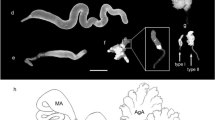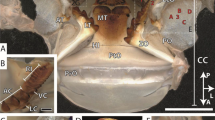Summary
A single layer of cells secretes the hard cephalopod beaks. The beccublasts are tall columnar cells that separate the beak from the surrounding buccal muscles, and must serve to attach these muscles to the beak. Within the cell layer there are three types of cells. The first, and most frequently found contain cell-long fibrils. These fibrils may have contractile and tensile properties. Complex trabeculae extend from the beccublasts into the matrix of the beak. The fibrils are attached to these trabeculae and at the other end of the cells they are anchored near to the beccublast-muscle cell interface, closely associated with the muscles that move the beak.
The second group of cells contain masses of endoplasmic reticulum the cysternae of which are arranged along the long axis of the cell. These cells also contain dense granules and are probably the major source of beak hard tissue. It is probable that each cell secretes its own column of beak hard tissue. The third group of cells contains a mixture of fibrils and secretory tissue.
In the beccublast layer there are changes in the proportion of the three types of cells depending upon the region sampled. In the region where growth is most active there are mostly secretory cells, whereas near the biting and wearing tip there are mainly anchoring type cells.
Similar content being viewed by others
References
Allan, J.H.: Maturation of enamel. In: Structural and chemical organization of teeth, vol. I (A.E.W. Miles, ed.). London: Academic Press 1967
Altman, J.S., Nixon, M.: Use of the beaks and radula by Octopus vulgaris in feeding. J. Zool. (Lond) 161, 25–38 (1970)
Boyde, A.: The structure and development of mammalian enamel. Ph. D. Thesis, University of London 1964
Boyde, A., Wood, C.: Preparation of animal tissues for surface scanning electron microscopy. J. Microsc. 90, 221–249 (1969)
Butcher, E.O.: Enamel rod matrix formation in the rat incisor. J. Amer. dent. Ass. 53, 707–712 (1956)
Clarke, M.R.: The identification of cephalopod “beaks” and the relationship between beak size and the body weight. Bull. Br. Mus. nat. Hist. (Zoology) 8, 421–480 (1962)
Clarke, M.R.: “Growth rings” in the beaks of the squid Moroteuthis ingens (Oegopsida: Onychoteuthidae). Malacologia 3, 287–307 (1965)
Hayward, A.F., Hackemann, M.: Electron microscopy of membrane coating granules and a cell surface coat in keratinized and non-keratinized human oral epithelium. J. Ultrastruct. Res. 43, 205–219 (1973)
Kallenbach, E.: Fine structure of rat incisor ameloblasts in transition between enamel secretion and maturation stages. Tiss. and Cell 6, 173–190 (1974)
Nixon, M.: Feeding mechanism and growth in Octopus vulgaris. Ph. D. Thesis, University of London 1968
Nixon, M.: Growth of the beak and radula of Octopus vulgaris. J. Zool. (Lond.) 159, 363–379 (1969)
Nixon, M.: Beak and radula growth in Octopus vulgaris. J. Zool. (Lond.) 170, 451–462 (1973)
Reith, E.J., Butcher, E.O.: Collagen formation in developing molar teeth of rat. J. Ultrastruct. Res. 21, 383–414 (1967)
Reith, E.J., Ross, M.H.: Morphological evidence for the presence of contractile elements in secretory ameloblasts of the rat. Archs. oral. Biol. 18, 445–448 (1973)
Reynolds, E.S.: The use of lead citrate at high pH as an electron-opaque stain for electron microscopy. J. Cell Biol. 17, 208–212 (1963)
Rudall, K.M.: Regular folds in protein and polysaccharide chains. The Scientific basis of Medicine Annual Reviews 1962, 203–214 (1962)
Rudall, K.M.: The chitin/protein complexes of insect cuticles. Adv. Insect Physiol. 1, 257–313 (1963)
Stephens, P.R.: Histological methods. In: The anatomy of the nervous system of Octopus vulgaris. J.Z. Young. Oxford: Clarendon Press 1971
Author information
Authors and Affiliations
Additional information
We are most grateful to Professor J.Z. Young, F.R.S., and to Dr. A. Boyde for helpful discussions of the work and critical reading of the manuscript. We should like to thank Mrs. E. Bailey, Miss T. Hogan, Mr. R. Moss and Miss P.R. Stephens for excellent technical and photographic assistance.
Rights and permissions
About this article
Cite this article
Dilly, P.N., Nixon, M. The cells that secrete the beaks in octopods and squids (Mollusca, Cephalopoda). Cell Tissue Res. 167, 229–241 (1976). https://doi.org/10.1007/BF00224330
Received:
Issue Date:
DOI: https://doi.org/10.1007/BF00224330




